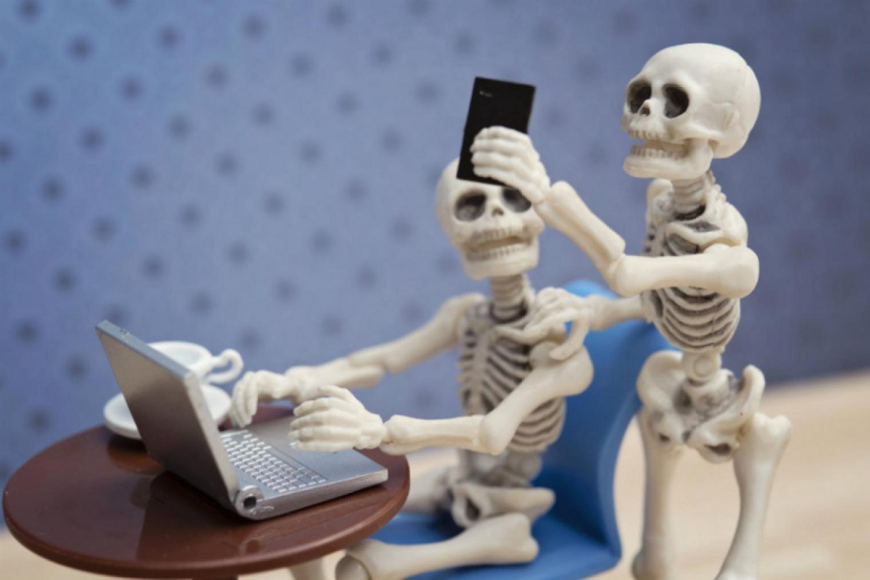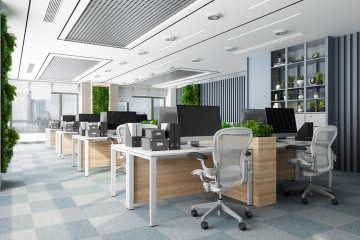Computers are humming. Some employees have returned to the office and others are working remotely. Company leaders are either strolling corridors or leading virtual meetings, offering words of encouragement. And with the excitement of the holiday season, the last health and safety incident is gone from recent memory. But like every seasoned EHS leader, you know evil risks and hazards often lurk below the surface. After all, lower risk doesn’t mean no risk.
So, you’re standing guard to protect your workforce. However, diabolical office dangers can also hide in plain sight—ready to strike when the moment is just right.
The good news? Like any *arguably* good scary movie, after the darkness comes the dawn; in the face of horror comes heroism.
Here we offer you the EHS tips and tactics you need to fend off harrowing, haunting, and hair-raising hazards to keep your office or remote working environment fright-free this Halloween and all year round.
1. Vanquish ghastly slip, trip, and fall hazards
Loose rugs or mats. Accidental spills that have yet to be cleaned up. Tangled cords. Obstructed sight lines. A helpful employee balancing on their roller-clad office chair as they attempt to change a light bulb. Ok, at home this may be your significant other or even your child - but either way - all are wicked slip, trip, and fall incidents just waiting to wreak havoc. In fact, slips, trips, and falls are some of the most common office incidents—and oftentimes, they’re preventable.
To cast out evil slip, trip, and fall hazards, educate employees on the importance of helping keep their spaces and the office clutter-free. You may not have control over their home office, but giving some tips and tricks as if they were still right down the hall may not be a bad idea. Train your employees to spot potential hazards and how to safely mitigate them.
Of course, finding creative ways to engage your employees in the conversation around slips, trips, and falls can be a dreadful challenge. Perhaps a little haunting humor will do the trick? Check out our roundup of “educational” slip, trip, and fall videos for a little inspiration.
2. Expel evil ergonomic risks
Proper ergonomics in lower-risk environments is one of the most commonly overlooked safety opportunities. Why? Like ghosts haunting a once lively, well-kept mansion, the effects of improper ergonomics take a slow toll on individuals—and can often be dismissed.
The Occupational Safety and Health Administration (OSHA) has studied ergonomics for nearly three decades, and has found that work-related musculoskeletal disorders (MSDs) such as carpal tunnel syndrome or tendonitis impact employee safety, comfort, and productivity—all of which have financial implications for companies.
For those employees working remotely, they should know how to properly set up a home office to banish evil ergonomic risks. This starts with an ergonomic assessment. Ergonomic assessments are meant to be an objective study of how employees are working, as well as help identify ergonomic risks. If you don’t have the in-house resources or expertise to check-in with employees virtually, let a health and safety consulting firm work their ergo magic.
3. Expose monstrous lighting situations
Dark corridors. Dimly lit basements. Pitch-black forests. When you’re watching a scary movie, the last thing you want a protagonist to do is to go willingly into the darkness—and the same should be true for your workforce.
Whether too bright or too dim, improper lighting causes eyestrain and can also mask unmitigated slip, trip, or fall hazards.
Consider providing desk lamps and dimming fluorescent lights for optimal computer screen viewing. In addition, make sure stairways, hallways, and other common areas are well-lit, with clear lines of sight to prevent tragic tumbles.
4. Extinguish devilish fire safety hazards
From fraying electrical cords to microwave mishaps, frightful office fires happen. A few years ago, the National Fire Protection Association (NFPA) used a five-year data set to estimate that fire departments respond to roughly 3,340 fires at office properties every year—with the vast majority of those being business offices.
To put an end to potentially devastating office (or home) fire hazards, start by regularly inspecting cords for all electric devices, making sure space heaters are being used properly and under the right conditions, and ensuring sprinkler systems are working and not blocked.
5. Unmask ghostly ghouls lying in wait
Every horror movie villain is an expert at hiding, waiting for the moment to reveal themselves and catch their prey off-guard.
Don’t wait for health and safety risks to appear, especially as cold and flu season approaches. If you didn't know before the pandemic, you probably now know who your EHS person or champion is at the company. If you don't have someone, designate a champion or two to proactively seek hazards out and make sure the office is taking the recommended or agreed upon COVID-19 and flu safety precautions.
In addition, as part of your efforts to build a culture of EHS, encourage your employees to feel comfortable reporting unsafe behaviors or situations in the office or out on job sites if applicable. Finally, know and monitor for signs of musculoskeletal disorders (MSDs) among employees so you can take action to optimize their workspace or give tips on how to improve their at-home work environment.
6. Put a spell on your employees
Defeating EHS evils is not a one-person job—it takes a collective effort and a focus on creating a culture of EHS. But you can use your expert EHS witchcraft to train your employees and conjure spellbinding engagement.
Double down on ongoing EHS training and engagement initiatives to keep health and safety top-of-mind. If your employees are working from home long-term, make sure you establish some basic minimum safety expectations. You can implement these safety practices in a more informal manner through trainings, webinars, one on one discussions between managers and employees, employee forums, email blasts, and other internal communication channels. Regular communication through a variety of channels will provide your employees with the right information and help build a strong EHS culture in your company.
A Healthy, Safe Work Environment is No Hocus Pocus
Health and safety terrors lurk in every home and office. But with a proactive focus on mitigating common hazards and empowering the entire team to rise to the occasion, you can prevent your work environment from turning into an EHS nightmare and get the last “mwuahahaha.”
Looking for more EHS tips and tactics with a twist? Learn what each of the Hogwarts Defense of the Dark Arts professors can teach you about risk management.
Read HereWant more news and insights like this?
Sign up for our monthly e-newsletter, The New Leaf. Our goal is to keep you updated, educated, and even a bit entertained as it relates to all things EHS and sustainability.
Have any questions?
Contact us to discuss your environment, health, safety and sustainability needs today.





